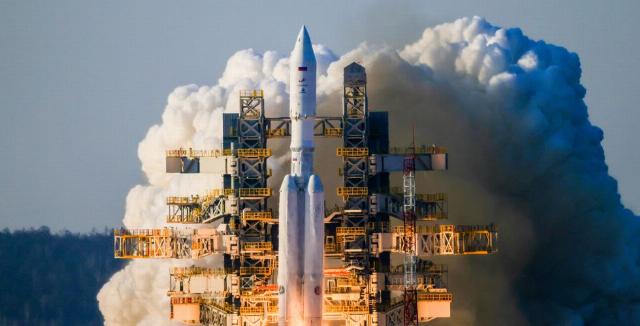In April, the Angara-A5 heavy launch vehicle was launched from the Vostochny cosmodrome for the first time. The launch of the upgraded, more lifting Angara-A5M is scheduled from Vostochny in 2027. It is on this rocket that the third stage, powered by hydrogen, may appear, and it is the Angara that may become the first returnable carrier in the history of Russian cosmonautics. Sergey Kuznetsov, General Designer of the Salyut Design Bureau named after V.M. Myasishchev (part of the Khrunichev Center of the Roscosmos State Corporation), told about the results of the first launch of the Angara from Vostochny, the timing of the operation of this carrier, preparations for the first launch with a crew and the creation of a reusable version of this rocket in an interview with Pro Cosmos.
— Sergey Viktorovich, how do you assess the first launch of Angara-A5 from Vostochny? What has been achieved, and what else needs to be worked on?
— First of all, we regard this launch of the Angara-A5 launch vehicle as an expansion of the capabilities of our products. This is not just a new launch point, which is certainly strategically important for the country, but also a significant increase in the payload capacity of the Angara, provided by the geographical latitude of the cosmodrome. We plan to develop this spaceport and modernize the rockets. The first launch of the upgraded Angara, Angara-A5M, is scheduled from the Vostochny cosmodrome in 2027. We have already started manufacturing components for it.
— The first launch was postponed twice, the reasons for the two cancellations of launches were established by the state commission. Will there be any changes in production to prevent similar situations in the future?
— Of course, all the comments that we received at the first test launch will be taken into account, and measures will be implemented that will exclude the possibility of their repetition at subsequent launches with standard payloads. We have just started flight design tests and for the first launch of the rocket from a completely new start, with a new, not yet worked-out infrastructure, I assess the work performed on April 11 at a fairly high level.
We have confirmed the technical and design solutions laid down during the development of the space rocket complex. I also want to note that our efforts will focus not only on these two remarks, absolutely all the issues that appeared during the preparation of the rocket in the MIC (installation and test building - ed.), and directly at the launch complex, will be analyzed and a set of measures will be implemented for each to ensure high-quality, trouble-free operation of the complex in the future.
— When are the next flight tests of the Angara from the East scheduled?
— The next launch from the Vostochny cosmodrome under the current contract implies the use of an already upgraded version of the Angara, the so-called Angara-A5M. Currently, work is actively underway to create this machine. The release of design documentation has been completed, the production of bench machines is underway and the production of the first two flight products has already begun. The specific launch date of these machines has not yet been determined and will depend on the tasks to be solved at these launches.
— Is the entire infrastructure on the launch table ready for subsequent launches, or has a minimum launch been created at the moment, which needs to be finalized? If the start-up is the minimum, then how long will it take to complete the construction?
— It is probably wrong to talk about the starting minimum, because serious work has been done from the point of view of preparing technological systems. All technological systems of this launch were practically in standard execution. As for the readiness of technical systems, for objective reasons related to incomplete construction, there were certain nuances in their use. But given that the launch received minimal damage during this launch, we are confident that the builders will be able to start completing the remaining work quickly enough, and the launch will be fully ready for the next launch.
 |
| The Angara-A5 heavy class missile. |
| Source: Natalia Berezhnaya |
— Earlier, the Director General of the Khrunichev Center reported that the modules of the promising Russian orbital station (ROS) will be launched using Angara-A5M launch vehicles. When will the creation of the first rocket for ROS begin in hardware? By what time will it be ready?
— Yes, the main transport supply of the promising Russian orbital station, ROS, falls on our upgraded machine, which I mentioned earlier and which we are already creating. All heavy modules for the prospective space station are planned to be launched at Angara-A5M. As I mentioned earlier, we have already started manufacturing parts and assembly units for the first two Angara-A5M flight vehicles. As for linking these two machines to specific modules of the ROS stations or for some other payloads, this is a matter of the near future. Currently, our colleagues from the RSC (Rocket and Space Corporation - ed.) Energia are determining the deployment strategy of the station, and for our part we are ready to fulfill all the tasks set.
— Is the Angara a fully domestic missile?
— Yes, the Angara is a completely domestic missile.
— Will the first ROS module, which will be launched with the help of Angara, be a scientific and energy one?
— According to current plans, the deployment of a promising Russian orbital station begins with the launch of a scientific and energy module. We expect that this will be the first module to be launched by the upgraded Angara from the Vostochny cosmodrome as part of the creation of this station. If our colleagues from RSC Energia make a different decision during the development of the station, then I think Angara will be ready to start deploying the station from any module that will be needed at that time.
— Previously, the project of the returned "Angara" was worked out. What kind of fuel are its flights supposed to use?
— As part of the preliminary design of the second stage of the Amur R&D (experimental design work - ed.), we considered the returnable version of the Angara-A5, already with a hydrogen 3rd stage. The preliminary design showed the possibility of creating such a modification. Moreover, its load capacity corresponds to the load capacity of the disposable version of the Angara-A5M on traditional components. Therefore, those loads that were planned to be launched on the Angara-A5M can be launched on this new returnable rocket.
— Will such a carrier be created on an initiative basis for testing, or is a government order required?
— At the initial stage of development, I think any project is proactive. After all, the task of the developer is to offer the customer those options from which you can choose the most interesting ones suitable for further implementation. We expect that this will be the case with the project of the returnable rocket.
If we talk about further implementation at our own expense, the Khrunichev Center is a joint-stock company with 100% state participation. Therefore, in any case, the decision of the state owner is necessary, where to direct public funds: to create a new launch vehicle, an innovative program, etc.
— In the future, there are plans to create an improved Angara-A5M, a hydrogen-powered Angara, and a reusable Angara. Are there any ongoing work on its further modernization/modification? Which ones? Or is it about creating a new rocket after that? Are there any developments?
— The modernization of the machine is constantly underway, and the example of our veteran — the Proton launch vehicle - shows that such a strategy allows you to keep up—to-date indicators in the launch services market for a long time. Therefore, of course, we will upgrade the Angara-A5M and create a hydrogen version of this machine. As I said, there are plans to create a reusable version, so we will implement all this if there is interest from the customer.
— When will the production of the first Angara for manned launches begin? How will it differ from "cargo"?
— The production of Angara for manned launches will begin after the relevant agreement is concluded. Now we have taken part in the preliminary design to ensure, among other things, manned launches to the ROS station, the customer was RSC Energia, we have submitted our proposals. We are ready to implement this project. As for the features, first of all, the manned "Angara" is distinguished by the presence of additional equipment related to the need to rescue the crew in case of possible emergency situations. Otherwise, structurally, this machine repeats the Angara-A5M and we expect that the manned version will become no less in demand than the cargo one.
— How many missiles will have to be launched in order to get the go-ahead to launch a promising crewed transport ship (PTK) on the Angara?
— So far, there is a preliminary vision of the manned version of the Angara. At the same time, we understand that the testing will be carried out in conjunction with the testing of a new manned spacecraft, new manned modules. Therefore, these programs will be interconnected. As for the number of launches preceding the launch of the PTK with the crew, then, of course, it will be necessary to take into account the previous history: how many modules were put into orbit, what were the results, how many comments were received. According to established practice, we believe that at least two or three launches of an upgraded manned rocket will need to be carried out in order to make a decision on launching the crew.
— Will it be necessary to upgrade the Angara-A5M launch vehicle when using multi-launch launch schemes for flights to the Moon? Are such works already underway?
— From the point of view of means of withdrawal, multi-start schemes do not differ from the withdrawal of conventional loads. That is, the task of the launch vehicle is to put the space head into a given orbit. And then all docking operations, module assembly takes place in orbit without the participation of launch vehicles.
There are certain requirements that are imposed on the ground-based space infrastructure, because in a short time it is necessary to carry out several launches of launch vehicles at once. But all these problems are fundamentally solvable. Therefore, in the presence of such tasks and, most importantly, in the presence of ships that will need to be delivered to the orbit of the Moon, of course, multi-launch schemes can be considered to complete the task.
— Is there any understanding of how long Angara will cover the needs of the Russian market? How long is it possible to use it?
— Of course, now we cannot say exactly how long the Angara will have a life. But we believe that it will serve the interests of the Russian Federation no less than its predecessor, our legendary Proton. Therefore, at least until the 50s, we see the "Angara" in service.
— Has it been possible to reduce the cost of production of Angara already? What kind of work is underway in this area?
— This work is ongoing. And the development of mass production, and the efforts and funds invested by both the state corporation and the Khrunichev Center in the development of mass production, undoubtedly give certain positive results. I really hope that in the near future the Angara launch vehicle will have a competitive price.
Alena Chiley

